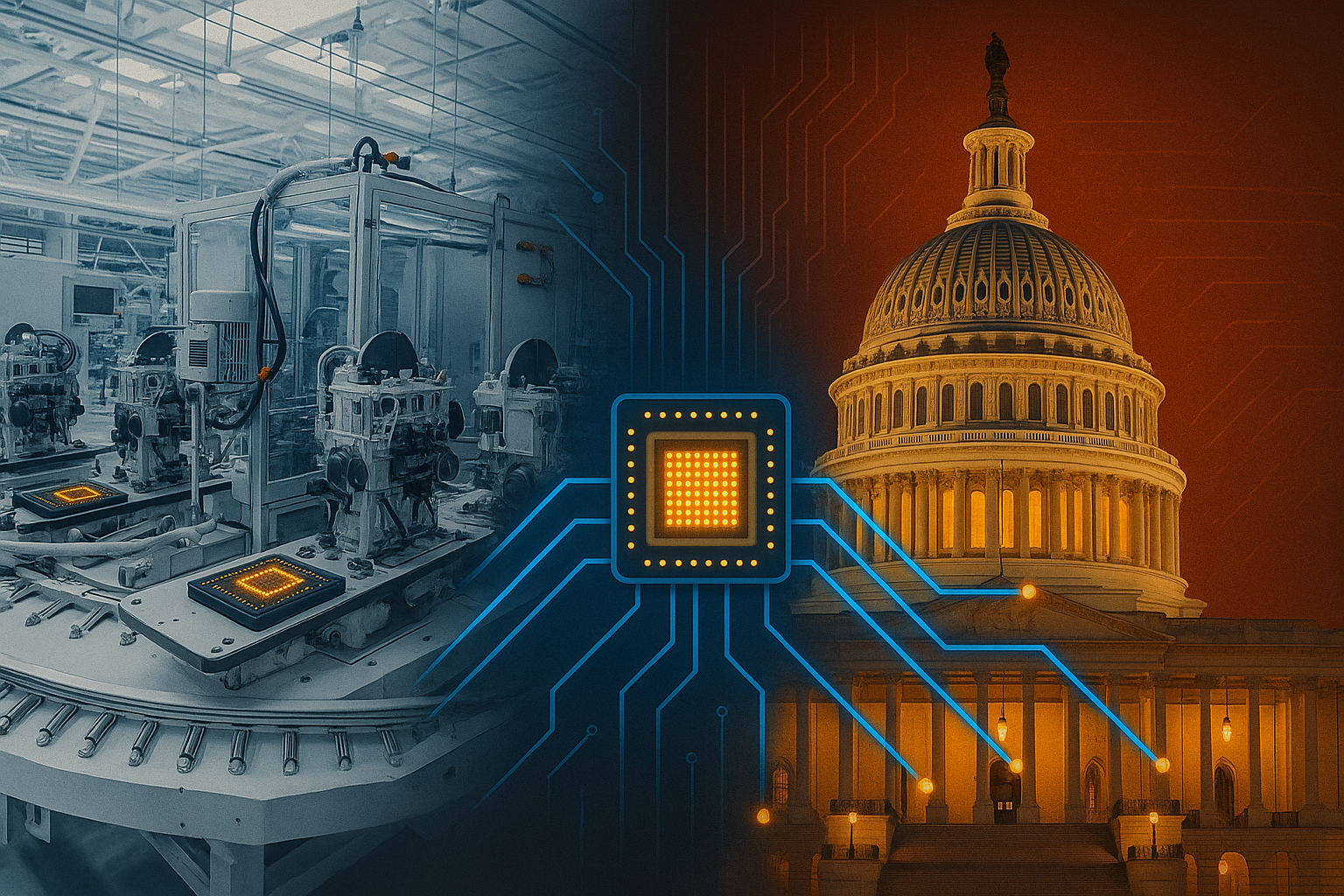
Share this Post
The CHIPS and Science Act, signed into law by President Joe Biden on August 9, 2022, marks a pivotal moment in modern U.S. industrial policy. With an authorized funding package of approximately $280 billion, of which $52.7 billion is dedicated to boosting domestic semiconductor manufacturing and research, the Act aims to address growing concerns about America’s technological competitiveness, national security, and economic resilience in a geopolitically volatile era.
Semiconductors are the foundational components of nearly every modern technology, from smartphones and automobiles to advanced weapons systems and artificial intelligence applications. Despite being a global leader in chip design, the United States’ share of global semiconductor manufacturing has declined from 37% in 1990 to around 12% in 2020, leaving the country highly dependent on overseas production, particularly in East Asia.
This dependency was starkly exposed during the COVID-19 pandemic, when global supply chain disruptions led to widespread chip shortages, hampering production across industries and prompting urgent calls for supply chain resilience. Concurrently, intensifying strategic competition with China has elevated semiconductors to a national security priority, with U.S. policymakers seeking to limit Chinese access to advanced chipmaking technologies while revitalizing domestic capabilities.
In this context, the CHIPS and Science Act is more than just a supply-side intervention, it represents a deliberate embrace of state-supported industrial policy, a significant shift away from decades of market-first thinking. Its implications extend beyond economics into geopolitics, innovation ecosystems, and the structure of the global technology order.
Legislative Overview
Enacted in August 2022, the CHIPS and Science Act authorizes approximately $280 billion in federal spending to boost U.S. competitiveness in advanced technologies. The centerpiece of the legislation is a $52.7 billion package aimed at strengthening domestic semiconductor manufacturing, research and development, and workforce training.
Of the $52.7 billion, $39 billion is earmarked for direct incentives to companies that build, expand, or modernize semiconductor fabrication facilities in the United States. Another $13.2 billion supports semiconductor R&D, testbeds, workforce development, and a new public-private National Semiconductor Technology Center. A separate provision offers a 25 percent tax credit on capital expenditures related to semiconductor manufacturing, estimated to cost an additional $24 billion over ten years.
The law also introduces “guardrails” to prevent federal subsidies from benefiting geopolitical competitors. Companies that receive CHIPS funding are prohibited from significantly expanding advanced semiconductor manufacturing in China or other countries deemed national security concerns for a period of ten years.
In addition to semiconductor-focused measures, the Act authorizes over $170 billion for broader scientific research and innovation. This includes new funding for the National Science Foundation, the creation of regional innovation hubs, and support for advanced materials and clean energy research. While this funding must be appropriated through future congressional budgets, it represents one of the most expansive research investments in decades.
Why Semiconductors Matter
Semiconductors, often referred to as “microchips”, are essential components in virtually all modern technologies. They power everything from smartphones, electric vehicles, and consumer electronics to military systems, satellites, and artificial intelligence applications. As the digital transformation of the global economy accelerates, access to advanced chips has become a strategic imperative.
The United States has historically led in the design of semiconductors, but over the past three decades, its manufacturing share has declined sharply. In 1990, the U.S. produced approximately 37 percent of the world’s semiconductors; by 2020, that figure had fallen to about 12 percent. Meanwhile, production has become concentrated in East Asia, particularly in Taiwan, South Korea, and China, raising concerns about supply chain security and geopolitical risk.
These vulnerabilities were exposed during the COVID-19 pandemic, when global supply chain disruptions led to widespread semiconductor shortages. The crisis delayed automobile production, increased costs for electronics, and constrained critical manufacturing sectors. In response, industry leaders and policymakers pushed for long-term investments in domestic capacity to reduce reliance on foreign suppliers.
The risks are particularly acute in national security. Advanced chips are vital to military capabilities, including precision weapons, cybersecurity infrastructure, and secure communications. Some emphasize that a loss of access to advanced semiconductors could critically weaken the U.S. defense industrial base.
Moreover, semiconductors have become a focal point in the U.S-China strategic rivalry. China has prioritized chip self-sufficiency through its “Made in China 2025” initiative, while the United States has responded with export controls and industrial subsidies intended to preserve its technological edge. The CHIPS Act thus reflects a growing consensus that control over semiconductor production is not just an economic issue, but a matter of geopolitical leverage.
Strategic Objectives
The CHIPS and Science Act serves multiple strategic aims at the intersection of national security, economic competitiveness, and industrial resilience. The legislation represents a reassertion of federal industrial policy to address long-standing vulnerabilities in the U.S. semiconductor sector and to secure technological leadership in the decades ahead.
Bolstering U.S. competitiveness in critical technology sectors
A central goal of the Act is to restore the United States’ capacity to manufacture semiconductors domestically. Although the U.S. remains a global leader in chip design, in 2020 it produced only about 12 percent of the world’s semiconductors, down from 37 percent in 1990. The legislation allocated $39 billion in manufacturing incentives and $13.2 billion for research and development and workforce training, aiming to reduce reliance on foreign suppliers and ensure the availability of advanced chips for both commercial and defense applications.
Addressing national security vulnerabilities
U.S. officials view semiconductor dependence on East Asia as a national security risk (particularly Taiwan, which produces over 90 percent of the world’s most advanced chips). Losing access to cutting-edge semiconductors could undermine U.S. military capabilities. The Act’s provisions aim to strengthen secure domestic supply chains and restrict firms receiving subsidies from expanding advanced manufacturing operations in China or other countries of concern.
Revitalizing regional manufacturing and job creation
The CHIPS Act is also designed to stimulate regional economic development. As of late 2023, over $200 billion in private investment had been announced in response to the law, supporting new fabrication plants in states such as Arizona, Texas, Ohio, and New York. These projects are expected to generate tens of thousands of high-paying jobs in manufacturing, construction, and engineering.
Reframing U.S. industrial strategy
The legislation reflects a broader shift toward proactive federal support for strategic industries, challenging the market-driven orthodoxy that has dominated U.S. economic policy since the 1980s. Proponents argue that the CHIPS Act could serve as a model for targeted industrial policy across other key sectors.
Taken together, these objectives demonstrate that the CHIPS and Science Act is more than an economic recovery effort. It is a long-term strategic initiative intended to consolidate U.S. leadership in technology, stabilize global supply chains, and prepare for intensifying geopolitical competition in high-tech domains.
Global Context
The CHIPS and Science Act has had wide-ranging international implications, triggering a global re-evaluation of semiconductor strategy. As the United States ramps up its industrial policy, both allies and strategic competitors have introduced parallel initiatives to secure their own technological resilience and influence the future of global supply chains.
European Union
The European Union introduced its own European Chips Act in 2022, with the aim of doubling the EU’s share of global semiconductor production to 20 percent by 2030. The initiative includes a planned €43 billion in public and private investment focused on research, design, and advanced manufacturing. Like its U.S. counterpart, the EU’s approach seeks to reduce dependence on East Asian production hubs and respond to geopolitical risks.
However, the strategy has drawn criticism. A report from the European Court of Auditors argued that the EU Chips Act suffers from fragmented implementation and unrealistic expectations. The report concluded that the bloc’s semiconductor ambitions were disconnected from reality, particularly given existing weaknesses in domestic manufacturing capacity and inconsistent coordination between member states.
China
China has treated semiconductors as a cornerstone of national strategy for over a decade. Through initiatives like Made in China 2025 and its broader push for “self-reliance in science and technology,” Beijing has directed substantial state funding toward domestic chip production. Still, China remains heavily reliant on imported semiconductors, particularly advanced logic chips needed for AI and high-performance computing.
According to Chinese customs data, semiconductor imports in 2023 totaled approximately $412 billion, illustrating both the depth of China’s demand and its current dependency.
In retaliation for U.S. export controls on advanced chipmaking tools and design software, China announced restrictions on the export of gallium and germanium, two critical materials used in chip production, signaling its willingness to weaponize raw materials in response to technology containment efforts.
U.S. Allies: Japan and the Netherlands
The CHIPS Act has also catalyzed policy alignment among U.S. allies. In early 2023, Japan and the Netherlands agreed to implement export controls on advanced lithography equipment and other semiconductor manufacturing tools destined for China. This move followed intense diplomatic engagement by the United States and effectively expanded Washington’s unilateral controls into a broader multilateral effort to restrict Beijing’s access to the highest-end chipmaking technologies.
The Netherlands, home to ASML, the world’s only supplier of extreme ultraviolet (EUV) lithography systems, plays a central role in these restrictions. Japan’s measures have focused on materials and etching equipment, further constraining China’s ability to manufacture leading-edge semiconductors domestically.
Criticisms and Challenges
Despite the scale and ambition of the CHIPS and Science Act, the program has faced several criticisms related to implementation, economic efficiency, workforce constraints, and political uncertainty. These challenges have prompted questions about the law’s long-term viability and return on public investment.
Implementation Delays
One of the most frequent criticisms concerns the slow disbursement of CHIPS Act funding. As of early 2024, only a limited number of grants had been awarded. Major fabrication projects have faced construction delays, often tied to permitting processes and site readiness. For example, Intel’s $28 billion semiconductor project in Ohio, initially heralded as the cornerstone of a U.S. manufacturing renaissance, has been pushed back to 2030 or later due to logistical and permitting setbacks.
Similarly, TSMC’s planned fabs in Arizona have been delayed because of labor shortages and complications with U.S. regulations. The project has been slowed, in part, by environmental permitting under the National Environmental Policy Act (NEPA).
Workforce Shortages
The United States also faces a shortage of skilled workers to meet the labor demands of the semiconductor sector. Estimates suggest that the country will require an additional 300,000 workers in science and engineering fields to support chip fabrication and research facilities. However, enrollment in relevant fields such as electrical engineering has remained flat since the 1990s, raising concerns about the available talent pipeline.
These shortages have impacted project timelines. TSMC reported difficulties in finding enough skilled American workers to complete its Arizona plant, prompting efforts to bring in experienced staff from Taiwan. However, those efforts encountered resistance from local labor unions, further complicating construction and staffing plans.
Funding Gaps for Research
Although the CHIPS and Science Act authorized over $13 billion for research and workforce development, only a portion has been appropriated by Congress. The National Science Foundation received roughly 42 percent less than the authorized level in its 2024 budget. This shortfall threatens to undermine long-term innovation goals, especially in areas like materials science, advanced packaging, and university-based chip R&D.
Political Volatility
The CHIPS Act has also become a flashpoint in partisan debate. President Donald Trump described the legislation as “a horrible CHIPS Act” and suggested it should be repealed and has explored altering or eliminating grant conditions and renegotiating contracts with recipient firms.
Such statements have created uncertainty for chipmakers planning long-term investments, as companies weigh the stability of federal commitments over the coming decade. Industry groups have expressed concern that abrupt policy changes could deter private-sector engagement and delay additional manufacturing announcements.
Economic Efficiency and Cost per Job
Finally, some economists have questioned the efficiency of the Act’s subsidies. A report by the Peterson Institute for International Economics estimated that each job created under the CHIPS Act could cost taxpayers as much as $185,000 per year, significantly higher than the average salary in the semiconductor sector. These findings have raised broader concerns about whether the subsidies are generating adequate public value relative to their cost.
Future Outlook
The CHIPS and Science Act has set in motion a major reorientation of U.S. industrial strategy, aimed at rebuilding domestic semiconductor capacity and securing technological leadership in the decades ahead. By allocating more than $50 billion in federal incentives for chip production, research, and workforce development, the Act is designed to reduce strategic dependencies and strengthen long-term economic resilience.
The private sector has responded positively to the CHIPS act. Since the Act’s passage, more than 80 semiconductor projects have been announced across 25 states, with over $450 billion in anticipated investment. Companies such as TSMC have made historic commitments, including $100 billion for fabrication plants and related infrastructure in the United States.
Despite this momentum, several structural challenges remain. Research and development funding has fallen short of authorized levels, limiting the federal government’s ability to support long-term innovation. At the same time, a severe shortage of skilled labor threatens to constrain the growth of new fabrication facilities. Experts estimate that as many as 300,000 additional workers will be needed by the end of the decade, yet enrollment in technical fields remains flat, and many companies report difficulties filling roles, especially outside established tech hubs.
Political volatility further complicates the outlook. President Donald Trump has criticized the CHIPS Act and proposed repealing or renegotiating parts of it, including existing award conditions. Such signals introduce uncertainty that may delay private-sector decisions or undermine the stability of long-term industrial policy.
Internationally, the CHIPS Act has reshaped the strategic landscape. The European Union launched its own Chips Act in 2022 with the goal of doubling its global production share by 2030, though implementation has been hampered by fragmentation and underfunding. Meanwhile, intensifying competition with China has placed semiconductors at the center of a broader geopolitical contest, with industrial capacity, supply chain control, and export restrictions emerging as instruments of strategic influence.
The CHIPS and Science Act is more than a reaction to recent supply chain disruptions. It marks a strategic shift in how the United States approaches national competitiveness in an era of intensifying technological rivalry. Whether this model becomes a durable framework for 21st-century industrial policy will depend on the government’s ability to translate funding into capacity, maintain bipartisan support, and adapt to global developments. If successful, the Act may serve as a blueprint for how liberal democracies can rebuild strategic industries in a fragmented and competitive global landscape.
Share this Post

Are Facebook and Its New Oversight Board Up to the Task When It Comes to Health Misinformation?
With much fanfare, Facebook’s newly established Oversight Board recently released its first batch of decisions on the social…

Fair Street Space Allocation
BarTalk in Tel Aviv: Experts from Israel and Germany discuss the future of urban mobility at a panel…

The Circular Valley
Circular Economy: Convincing in Theory, Still Weak in Practice The Circular Valley is a regional initiative currently bringing…
